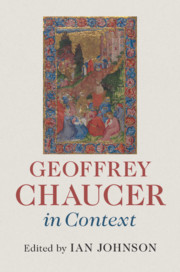Book contents
- Geoffrey Chaucer in Context
- Geoffrey Chaucer in Context
- Copyright page
- Contents
- Illustrations
- Contributors
- Abbreviations
- Introduction
- Part I Chaucer as Context
- Part II Books, Discourse and Traditions
- Chapter 3 Chaucer’s Linguistic Invention
- Chapter 4 Chaucer and London English
- Chapter 5 Manuscripts and Manuscript Culture
- Chapter 6 Chaucer’s Books
- Chapter 7 Authority
- Chapter 8 Literary Theory and Literary Roles
- Chapter 9 Metre and Versification
- Chapter 10 Dialogue
- Chapter 11 Romance
- Chapter 12 Love
- Chapter 13 Chaucer and the Classics
- Chapter 14 The French Context
- Chapter 15 The Italian Tradition
- Chapter 16 The English Context
- Chapter 17 Chaucer’s Competitors
- Chapter 18 Boethius
- Part III Humans, the World and Beyond
- Part IV Culture, Learning and Disciplines
- Part V Political and Social Contexts
- Part VI Chaucer Traditions
- Further Reading
- Index
Chapter 15 - The Italian Tradition
from Part II - Books, Discourse and Traditions
Published online by Cambridge University Press: 24 June 2019
- Geoffrey Chaucer in Context
- Geoffrey Chaucer in Context
- Copyright page
- Contents
- Illustrations
- Contributors
- Abbreviations
- Introduction
- Part I Chaucer as Context
- Part II Books, Discourse and Traditions
- Chapter 3 Chaucer’s Linguistic Invention
- Chapter 4 Chaucer and London English
- Chapter 5 Manuscripts and Manuscript Culture
- Chapter 6 Chaucer’s Books
- Chapter 7 Authority
- Chapter 8 Literary Theory and Literary Roles
- Chapter 9 Metre and Versification
- Chapter 10 Dialogue
- Chapter 11 Romance
- Chapter 12 Love
- Chapter 13 Chaucer and the Classics
- Chapter 14 The French Context
- Chapter 15 The Italian Tradition
- Chapter 16 The English Context
- Chapter 17 Chaucer’s Competitors
- Chapter 18 Boethius
- Part III Humans, the World and Beyond
- Part IV Culture, Learning and Disciplines
- Part V Political and Social Contexts
- Part VI Chaucer Traditions
- Further Reading
- Index
Summary
Chaucer’s two recorded visits to Italy in the decade of the 1370s is the starting point for considering vernacular literature at a point of transition: the middle of the decade is marked by the death of Petrarch and Boccaccio, and the beginning of the Chancellorship of Coluccio Salutati, a key figure in Florence’s incipient humanism. This chapter briefly examines some of the most important Italian influences on the work of Geoffrey Chaucer, namely: Dante Alighieri (1265-1321), and in particular the Comedìa; Giovanni Boccaccio (1313-1375), whose Decameron, Filostrato and Teseida were so important for Troilus and Criseyde, the Knight’s Tale, as well as the Canterbury Tales more generally; and Francesco Petrarca (1304-1374), who is attributed in the Clerk’s Tale as the source for the story of Griselda (his Latin translation of Boccaccio’s story comprises the seventeeth of his letters of old age, the Res seniles), and whose sonnet from the Rerum vulgarium fragmenta is included in Troilus and Criseyde.
Keywords
- Type
- Chapter
- Information
- Geoffrey Chaucer in Context , pp. 126 - 131Publisher: Cambridge University PressPrint publication year: 2019

